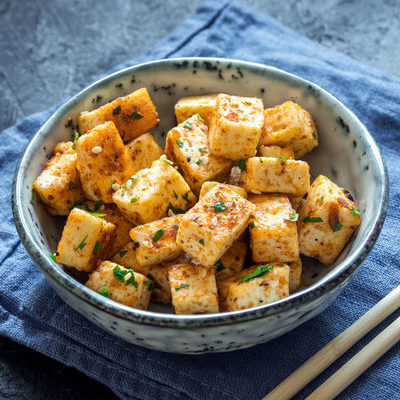
Tofu
also known as Bean Curd
What is Tofu?
Tofu is made from curdled soybeans that have been pressed into blocks. This food is often packed with Nagari, or the liquid that remains after removing seawater, for conservation purposes.
- Today, this is regarded as a protein-rich, healthy food and is popular in a variety of cuisines.
- The name of this food comes from the Mandarin Chinese word “doufu” which means “curdled bean”
The United States is the global leader of soybean production and produced a total of 107 million tons of this bean in 2016. With a rise in vegetarianism and veganism, tofu consumption in the US continues to rise each year.
The top 10 most popular brands in the US, according to Ranker are:
- Fresh & Easy Neighborhood
- 365 Organic
- Mori-Nu
- Soga
- House Foods
- Wildwood
- Sol Cuisine
- Pulmuone
- Saffron Road
- Sunrise Soya Foods
Origin of tofu
Legend has it that tofu was born when a Chinese chef one day decided to experiment with boiled soybeans and nagari. Although there are many theories about how it came to be, there is evidence of this food as far back as the Han Dynasty (206 BCE – 220 CE). Kento priests who spent time in China later brought this food back to Japan during the Nara Era (710-794). This food flourished and soon became popular all over the rest of Asia as a meat substitute.
The first record of this food being described as tofu was 1182, however, it would soon earn other names in Japan. Nonetheless, the Chinese continued to refer to this food as “bean curd”. Knowledge about this food would later spread to Europe, as can be seen by many 17th and 18th century texts. It took some time for this food to become well-known in the west, however, the rise of health food in the 1960s made it very popular.
Function
While this bean curd often gets a reputation for being bland and flavorless, it’s very versatile and can actually take on any flavor. You can stir fry tofu and add it to rice or noodle dishes. It’s also very common to marinate and bake it to add it to salads or sandwiches. In Asia, this food is traditionally used in soups and served with deep, complex broths. Tofu even adds texture to creamy desserts like ice cream, pudding, or mousse.
Nutrition
The nutrition of each type of tofu depends largely on the commercial producer, brand, and whether or not the food is fortified with minerals. However, this food is usually low-calorie, low-fat, low in carbohydrates, and offers a good source of protein. This food can also contain minerals, such as:
- Calcium
- Selenium
- Manganese
- Iron
- Magnesium
Tofu may help lower LDL cholesterol levels, as well as reduce the risk of breast cancer. Regardless, the level of processing required for this food may not make it suitable for everyone. This food can affect people with feminization, fertility, and other possible health risks.
Commercial Production
The commercial production begins with soaking soybeans in cold water for 18 to 24 hours. Once they are soaked, the soybeans will have doubled in size and become much softer, so they are sent off to be crushed. In a machine, the beans are crushed and filtered through a screen to become a soup of bean, grain, and pulp. Next, the mixture is turned into a paste by heating it for 3-4 minutes, after which it’s sent to a centrifuge machine. This part of the process separates the milk from the soymeal of which the latter is sold off as feed for cattle.
The remaining soy milk is used to create tofu. Soy milk is sent to a coagulation tank to be thickened, sometimes herbs and spices are added, if it is a flavored product being produced. Magnesium chloride and water are added to the tank to help the liquid coagulate and become solid. Finally, the resultant is drained of excess liquid, molded into blocks, pressed, cut, and packaged. For good measure, the packaged blocks pass through a pasteurizer before they are cooled and stored until ready to be sold.
Uses
It always comes packed with a bit of water to keep it fresh. If you have any leftovers that you want to keep, you should put them in a container, add fresh water, and place them in the refrigerator. When stored like this, it’s best to consume this food within two to three days. It’s also possible to freeze this food, however, it’s necessary to remove all excess liquid before freezing it. After freezing it, bear in mind that this food will need to be thawed before you can use it.
Some common types of tofu include:
- Firm
- Extra-firm
- Fermented
- Stinky
- Dried
- Frozen
- Tofu puff
- Tofu skin
Tofu recipes
With a bit of creativity, it can transform just about any dish. Here are some popular recipes:
- Stir-Fried Bok Choy with Tofu Skin
- Peanut Tofu Sushi
- Silken Tofu Chocolate Mousse
- Vegan Spaghetti Carbonara with Tofu Bacon Bits
- Korean Tofu Soup
FDA Regulation
The Food & Drug Administration does not currently have a standard of identity for tofu. Nonetheless, the FDA does regulate its labeling and details the exact reference amount and label statement that can be used on its packaging. On the other hand, the USDA has classified this food as a meat substitute that is suitable for both children and adults.
References
Wan, Liv. “Tofu History-Chinese Cuisine.” Thespruceeats.com, The Spruce Eats, 10 July 2018, www.thespruceeats.com/tofu-history-in-chinese-cuisine-4090272.
“History of Tofu.” Soyinfocenter.com, SoyInfo Center, www.soyinfocenter.com/HSS/tofu1.php.
Wicks, Lauren. “What Is Tofu, and Is It Healthy?” Cookinglight.com, Cooking Light, 27 June 2019, www.cookinglight.com/eating-smart/nutrition-101/what-is-tofu.
“CFR – Code of Federal Regulations Title 21.” Accessdata.fda.gov, U.S. Food & Drug Administration, 1 Apr. 2019, www.accessdata.fda.gov/scripts/cdrh/cfdocs/cfcfr/cfrsearch.cfm?fr=101.12.
